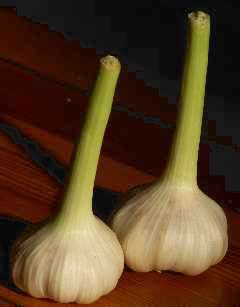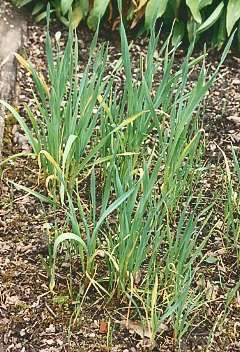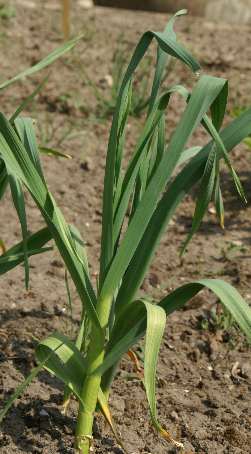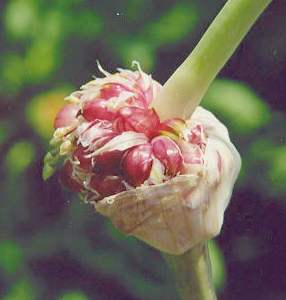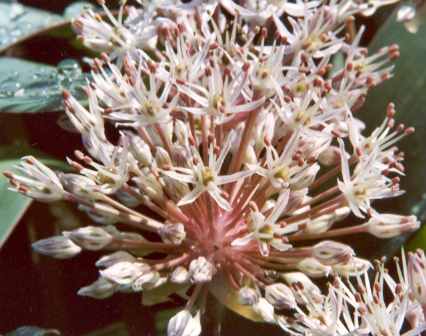
|
| Garlic plant |

|
| Garlic field |
In Europe, garlic has been a common spice since the days of the Roman Empire, and it was extensively used from India to East Asia even before the Europeans arrived there. After the Age of Exploration, its use spread rapidly to Africa and both Americas. Curiously enough, in our days Northern Europeans seem to be the only ones who look on it with suspicion because of its strong smell, which is sometimes felt unpleasant.
Some cuisines are fond of raw garlic. In parts of Austria, salads (based on lettuce) are prepared with vinegar, oil and minced garlic. The more Northern practise of rubbing the salad bowl with a halved garlic clove (and discarding the clove afterwards) is generally frowned upon, and the tasty pumpkin seed oil is preferred over bland refined vegetable oils.
Raw garlic appears in quite a multitude of Mediterranean sauces. Prominent examples are the Provençal specialty aïoli, basically a mayonnaise based on olive oil and enriched with garlic; furthermore, Greek skordalia [σκορδαλιά] a paste made from cooked potatoes and raw garlic, and Turkish çaçık, a refreshing soup made from plain yoghurt, shredded cucumber, garlic and peppermint leaves. A similar, but thicker, saucy product is known as tsatsiki (also spelled tzatziki [τζατζίκι]) in Greece, where it is often served to barbecued lamb souvlaki [σουβλάκι]. Many appetizers from West Asia (e. g., hummus, see sesame) contain some fresh garlic. Occasionally, minced garlic is spread along the edge of Italian pizza (see oregano).
A number of salads or appetizers with raw garlic is found in Georgia, where it is usually ground to a paste together
with walnut and herbs like parsley, celery or
coriander. Such a paste may be spread over fried aubergine slices
(badrijani [ბადრიჯანი],
often served with fresh pomegranate seeds) or may be mixed with vinegar to yield
a dressing for tomato and cucumber salad
(k’it’ri-k’amidoris salata [კიტრი-კამიდორის სალათა],
usually topped with parsley, coriander and/or basil leaves).
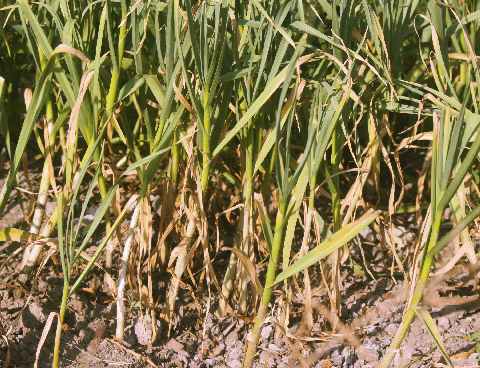
|
| Garlic plants in a garden |
In China, raw garlic appears in many salads, for example suan ni huang-gua [蒜泥黄瓜], crunchy cucumber cubes with a dressing of vinegar, sesame oil and garlic, topped with coriander leaves. Yet similar appetizers (also employing dried chiles, chile oil or soy sauce) are prepared with many more vegetables (string beans, steamed leaves) or glass noodles. A non-vegetarian example is hong-you ji-si [红油鸡丝], thin strips of boiled chicken breast dressed with chile oil and garlic. A mixture of finely chopped garlic and sesame oil (diluted with bland vegetable oil to taste) is often served as a dip on the table.
Remotely similar but rather spicy and salty snacks with raw garlic, often entire garlic cloves, are found in the highly original cuisine of the Newar people in Nepal. In addition to the usual set of Indian spices (e. g., fenugreek, cumin, and fennel), the Newari have a rather untypical fondness for raw garlic and ginger, which appear together with large amounts of fresh or dried chiles in cold salad-like foods that are enjoyed during the day, together with dry beaten rice and a bottle of beer: Choyela or choila [छोयला or छोईला] (barbecued buffalo meat dressed with dried chile, fresh ginger, garlic and an aromatic local mustard oil), satu mhicha [सतु म्हिचा] (small pockets of buffalo stomach stuffed with bone marrow), musya palu [मुस्या पालु] (green soy beans with sliced garlic and ginger) and the strange jala [जला], small pieces of boiled buffalo skin (with some meat attached) seasoned with garlic, chile and dark toasted fenugreek seeds. Another example is the lean raw buffalo mince kochila [कोचिला] mixed with mustard oil, which is usually served with loads of raw garlic cloves.
Vampyres have no chance in Vietnam, particularly around Hanoi [Hà Nội]: Freshly
grated garlic is served in liberal amounts to spring rolls and soups in
Northern Vietnam (see Vietnamese cinnamon for an
account of the Hanoi style beef soup). The latter is an example demonstrating
the subtle effect that can be achieved by adding grated or squeezed raw garlic
to a dish that already contains cooked garlic.
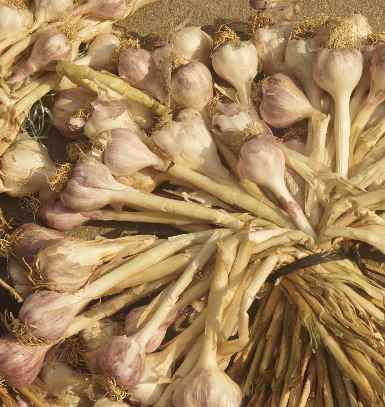
|
| Garlic fresh after the harvest |
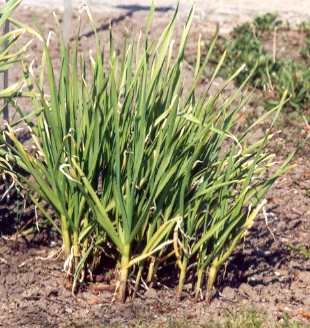
|
| Young garlic plants |
Raw garlic may also be pickled in vinegar or olive oil. Since some of garlic’s aroma is extracted by the liquid, and since little cell damage occurs before the enzymes get dysfunctional, pickled garlic is usually very mild. Herbal vinegar (see dill) is commonly made with one or two garlic cloves per liter vinegar.
A unique garlic flavouring is the Tibetan garlic water
, gog-chu [སྒོག་ཆུ་].
This consists of very slightly crushed garlic cloves that are left to macerate with water,
sometimes in combination with dried Sichuan pepper. A few
drops of vinegar may be added for preservation. The water acquires only a mild garlic
flavour and may be sprinkled over salads; in Ladakh, it was also served to the national noodle dish,
momo [མོག་མོག་]
(see Sichuan pepper).
Usage of fried or cooked garlic is, however, much more common and found in almost every cuisine of the world. On heating, the pungency and strong odour get lost and the aroma becomes more subtle and less dominant, harmonizing perfectly with ginger, pepper, chiles and many other spices. An interesting example from Northern Italy is bagna cauda, a sauce made by cooking garlic cloves in olive oil very slowly, adding pungent fermented anchovies (acciughe) and puréing. In Piedmont, bagna cauda is served as a dip with raw or slightly cooked vegetables. Another Italian recipe depending almost entirely on garlic are the spaghetti aglio olio e peperoncini, boiled pasta with garlic and dried chiles shortly fried in olive oil.
Different Asian cuisines make different use of this very versatile spice. Many Indian recipes add garlic in an early phase, and it is fried for a long time together with onion and other spices to provide the basic masala; in the finished dish, the garlic taste is no longer discernible, but has merged totally with the other components. In contrast, although Indonesian and even Chinese stir-fries usually start with frying a few cloves of garlic, a faint garlic aroma persists until serving because of the much shorter cooking time. In Indonesian cuisine, mixtures based on minced garlic, ginger and chiles are frequently used to season meat pieces before roasting or grilling (see lesser galangale for details and see also lemon grass for the spice paste bumbu).
In Thai cuisine, it is common to fry garlic slices in very hot oil to a
crisp texture, and decorate foods with these brown, crisp garlic slices.
Yet other Thai recipes avoid the frying of garlic but prefer gentle
simmering for spicy soups or creamy curries. Garlic is also an
essential component of its curry pastes (especially the green
one), see coconut. Similar custom
is found in Cambodia, where pastes of garlic, together with chiles, lemon grass or ginger, are added to soups or stews.
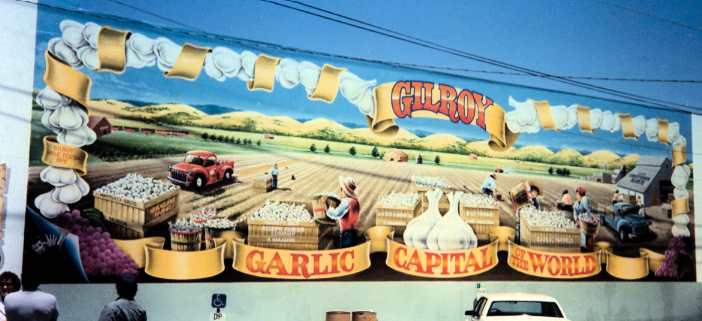
|
Mural in Gilroy, the Californian garlic capital |
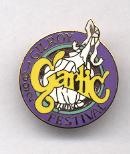
|
| Gilroy Garlic Festival |
In the southern states of the US, garlic is also very popular. The small town
of Gilroy (in California, not far from San Francisco) claims to be the garlic
capital
of the world; although not quite true, the claim seems plausible to
every visitor in end of July, when the annual garlic festival
is held and
garlic recipes are evaluated — allegedly, they even serve
garlic ice cream (see also vanilla).
The Gilroy area is also the main garlic producer for the US market, as can
easily be smelled at harvest time. There has been the saying that steaks
can be marinated in the air of Gilroy. That’s clearly exaggerated, but not
necessarily much so.
Gilroy mainly produces dehydrated garlic, which is more popular in the USA than in other countries. Dried garlic, however, also makes an appearance in East African
cooking, and it is the characteristic flavour in the Georgian table condiment
svanuri marili [სვანური მარილი] (Svanetian salt
),
a coarse ochre powder made from salt, garlic, coriander, dill, savory,
cumin, blue fenugreek and a dash of chile.
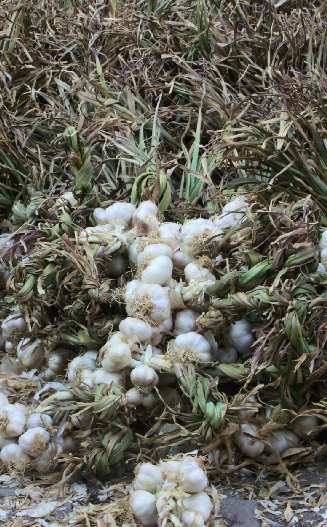
|
| Garlic after the harvest |

|
| Garlic drying after harvest in Nepal |
Garlic consumption is also high in Central America, where the bulbs are, among others, used for Mexican mole (see paprika) and salsa (see long coriander).
Garlic is much less popular in today’s Europe, where it is used only with care, except the Southern European countries. Northerners seem to loathe the faint garlic odour that is emitted by garlic eaters even many hours after the garlic consume. There is no perfect remedy against it, but eating chopped parsley, hot showering and excessive tooth brushing will remove at least the greater part of it.
In recipes from North or Central Europe, garlic is normally cooked for a long time to reduce it odour; furthermore, its aroma is thereby sufficiently damped to fit better to the rather mild food of this region. Cooks tend to use garlic together with some Mediterranean herbs (thyme, bay leaves), but also with indigenous spices like juniper and caraway.
Cooks in Southern Europe tend to use garlic much more liberally. It is commonly combined with pungent chiles (e. g., Italian spaghetti aglio ed olio, spaghetti noodles with garlic and olive oil); garlic finely cut and suspended in olive oil together with parsley leaves is often served to barbecued fish in Croatia. Garlic is a main constituent of most Mediterranean sauces; some examples using raw garlic were given above. Food prepared with both red or white wine calls for some garlic: Rabbit stewed in red wine together with generous amounts of garlic and bay leaves is a national dish in Malta (Fenek bit-tewm u bl-Inbid), and Portuguese porco vinho e alho (fried pork cubes that have been seasoned with white wine and garlic) is delicious; the latter food was adapted to South West India, where it is known as vindaloo [विंदालू] (see tamarind).
Also, Eastern Europe has a lot of garlic tradition: From the Balkan to the Baltic, garlic is found in soups, sauces and salads. Serbia and Hungary have a fine reputaton for their garlic-laden foods, but also the Black Sea countries Bulgaria and Romania use it a lot. On the Eastern coast of the Baltic sea, garlic is often consumed in salads and other cold foods, preferably raw and squeezed; for example, small cubes of dry black rye bread shortly fried in oil with some garlic make a snack commonly eaten in Lithuania, typically to go with a glass of beer.
Of botanically related plants, onion is certainly
the most important. Even more closely related is bear’s
garlic, whose fresh leaves have some tradition in Central Europe.

